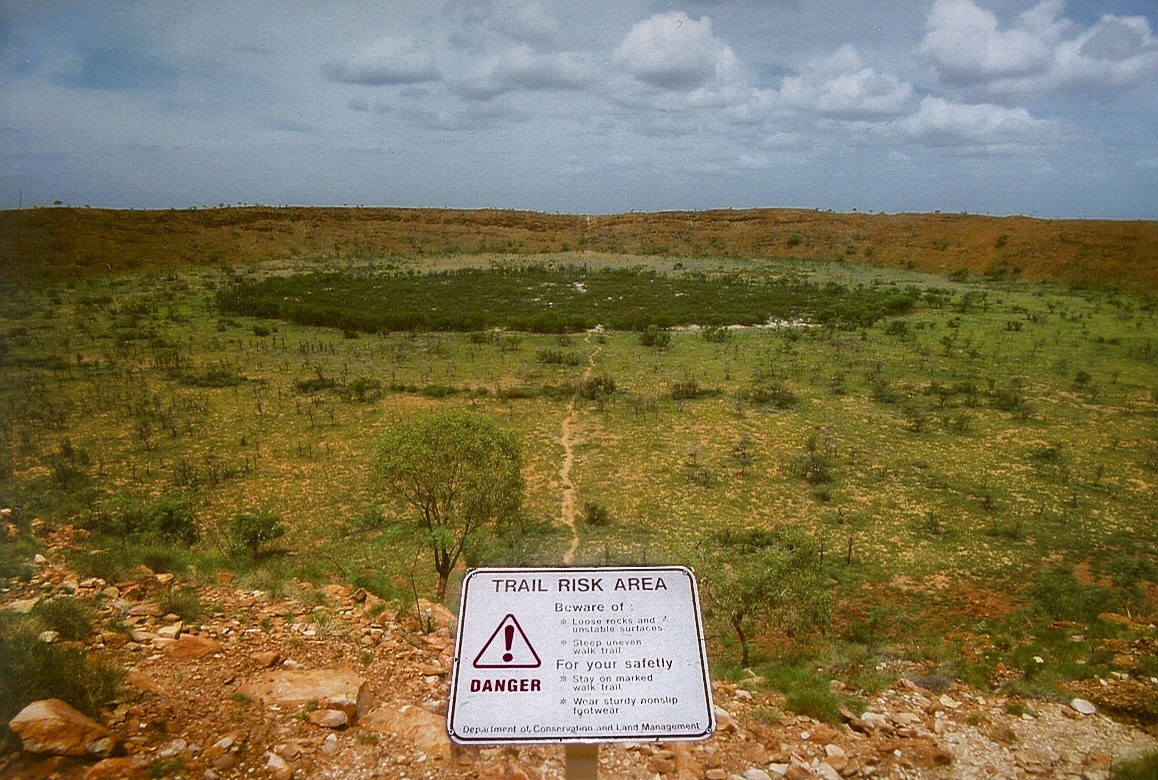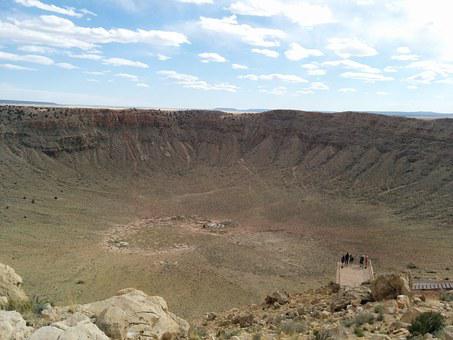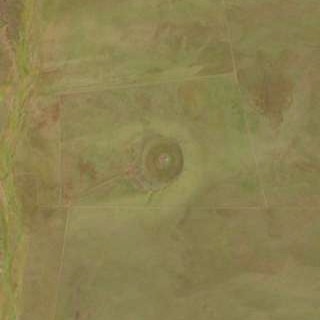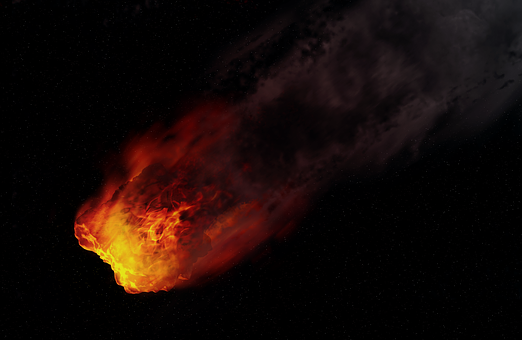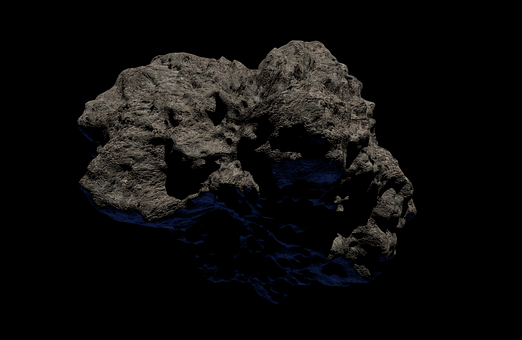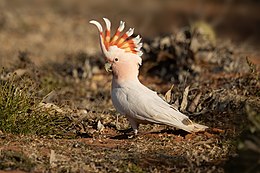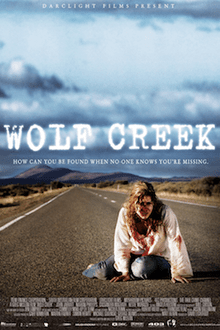Australian Aborigines had long known of the existence of the crater near Wolfe Creek when an aerial survey identified this impact crater in 1947. Wolfe Creek Crater is almost circular and is believed to be the second-largest crater in the world. It is one of the best-preserved impact craters in the world. However, the fragments collected from the impact crater show the classic features of a meteor hitting the Earth’s surface.
The deep green color of the crater indicates vegetation lining the meandering stream to the west of the crater. A road approaching from the south leads to the rim of the crater and turns east. Also, the impact crater is quite brown with a bright white patch at the center of the crater. According to geologists, Wolfe Creek Crater was formed 300,000 years ago when a meteorite weighing more than 15,000 tons hit the Earth’s surface which is now Australia.
Formation of Wolfe Creek Crater
Wolfe Creek Crater is approximately 880 meters (2,890 feet) in diameter, whereas the flat crater floor is approximately 55 meters (180 feet) below the rim of the crater and approximately 25 meters (82 feet) below the surrounding sand. However, the ground at the center of the crater rises slightly including gypsum which gives a bright white patch.
Inside the impact crater, there are large trees. The trees draw the moisture from the water reserves in the crater left after the summer rains.
How Old Is Wolfe Creek Crater?
According to geologists, a meteorite weighing more than 50,000 tons hit the Earth’s surface 300,000 years ago. It is estimated that the meteor was traveling at a speed of 9.3 miles (15 km) per second. Along with punching a hole in the Earth’s surface, the impact from a comet or asteroid shattered the rocks below the ground’s surface. Furthermore, the energy created due to an impact was converted into heat which vaporized the meteorite and the earth rocks nearby.
The explosion caused by the meteorite impact dispersed the debris and rocks in all directions. Some of the rocks within the impact are now the result of the meteorite itself. These rocks are now rusty balls of ferrous shale. Also, they occur in groups that can weigh up to 250 kilograms (550 pounds).
Discovery of Wolfe Creek Crater
In 1947, it came to the attention of scientists after it was spotted during an aerial survey. Two months later, scientists started studying the impact crater and published their findings in 1949. The impact crater’s European name comes from a nearby Creek which in turn was named after Robert Wolfe. The early reports misspelled it as Wolf Creek. Robert Wolfe was a trader and prospector during the gold rush. As a result, the town of Halls Creek was established.
Cultural Significance
Wolfe Creek Crater is called the crater Kandimalal by the local Djaru (Jaru) Aborigines. There are several dreaming stories about the formation of the crater. One of the dreaming stories describes the round shape of the crater formed by the passage of a rainbow serpent out of the ground. Sturt Creek, on the other hand, was formed by another serpent near the Wolfe Creek Crater.
Another story told by an Elder about Wolfe Creek Crater was that one day the evening star and the crescent moon passed very close to each other. As a result, the evening star became so hot that it fell to the ground causing a huge explosion and flash followed by a cloud of dust.
Due to a hypervelocity star hitting the earth’s surface, people got scared and it took a long time before they ventured to the impact crater. It was finally realized by them that it was the site where Evening Star had fallen. However, the impact crater site was named Kandimalal by the Djaru people.
New Findings On Wolfe Creek Crater
The Wolfe Creek Crater in Australia is much younger than previously thought. It has allowed scientists to calculate how often meteorites hit the Earth with massive nuclear explosion force. The University of Wollongong led an international team that used two different techniques to date the crater created by a meteorite hit.
The first technique was to remove the rocks from the rim of the crater that was ejected during a meteorite impact. The ejected rocks create a fresh surface that was exposed to the radiation. As a result, the team was able to determine the date of the exposure to the stones.
The second technique, on the other hand, was to look at the dune field deflected by the crater. As a result, they found a 15-meter-wide iron meteorite that hit the earth’s surface about 120,000 years ago. It is approximately half of the previously estimated age of the impact crater which was 300,000 years ago.
Another Interpretation
It is estimated that the Wolfe Creek Crater was formed 300,000 years ago. However, people arrived in Australia 65,000 years ago. It means that during an impact, there was no population living in the area which is now Australia. But given that western society was still debating the formation of the Wolfe Creek impact crater.
Aboriginal significance, on the other hand, has a story told by an Elder that they have witnessed the meteorite making an impact on the earth’s surface. It is considered an Evening Star or shooting star by the Aboriginal people. However, even if the Wolfe Creek Crater was formed 120,000 years ago, there was no civilization in Australia. It means there is no evidence for that but just a cultural significance.
Visiting Wolfe Creek Crater
The public is encouraged to visit the Wolfe Creek Crater during the dry seasons such as from May to October. There is a gravel road to the impact crater site which is not suitable for unconventional vehicles. To reach the rim of the crater, there is a 400-meter (1,312 feet) hike involving a steep rock climb. Due to the loose rocks, the descent into the crater is prohibited because it makes it dangerous for tourists.
Wildlife in Wolfe Creek Crater
Wolfe Creek Crater is home to interesting wildlife such as brown ring-tailed dragon lizards foraging for insects. Also, you might hear the striking calls of Major Mitchell’s Cockatoo collecting seeds from plants at the bottom of the crater. These pink birds harvest seeds from the paperbarks and wattles of the crater floor.
Cultural Reference
- Wolfe Creek Crater was featured in the 2005 Australian horror film Wolf Creek. Later on, it was featured in the 2013 Sequel, Wolf Creek 2. Also, it appeared in the original television series with the same name.
- Wolfe Creek Crater was the setting of The Will of the Tribe written by Arthur Upfield in 1962.
- After the famous Barringer Crater, the Wolfe Creek Crater is considered one of the most prominent meteorite craters on earth.
- Wolfe Creek Crater is mentioned in the 2010 Alienology, a science fiction book for children. In the book, it is said that a spaceship crashed here.
Wolfe Creek Crater – A 300,000 Years Old Impact Crater
Wolfe Creek Crater is located on the edge of the sandy desert in western Australia. It is the second-largest crater in the world which was created 300,000 years ago. However, according to the latest study from the University of Wollongong, it is found that a meteor made an impact on the Earth’s surface 120,00 years ago. Furthermore, there are dreaming stories about the formation of Wolfe Creek Crater by Aboriginal people.
Wolfe Creek Crater is one of the top 10 craters on Earth. It has been best preserved by the authorities and government. Also, there is a Wolfe Creek Crater national park that allows visitors to visit Wolfe Creek Crater during the dry season. Visitors can go for a hike or camping at the impact crater site. If you are lucky enough, you might get to hear Major Mitchell’s Cockatoos’ striking calls.

